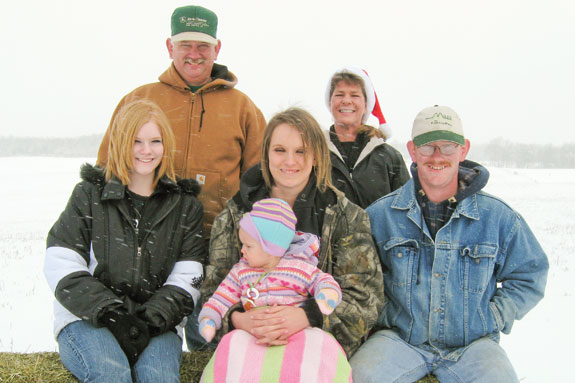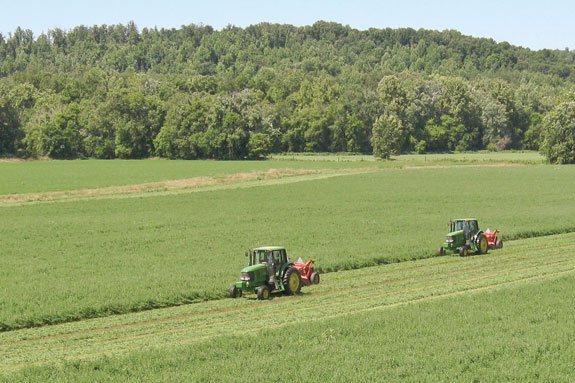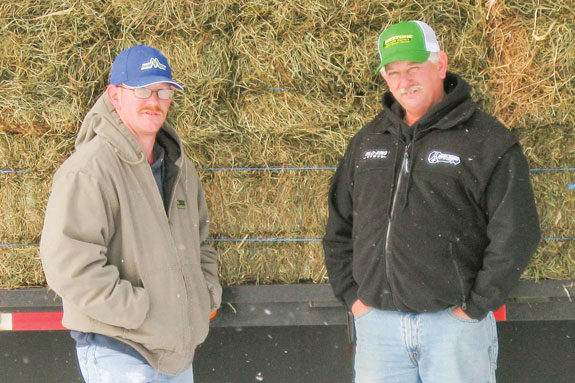For others, the yesteryear staples of tobacco or cozy nooks with beef cows lazily grazing spring into thought. While a number of images could come into play, one that is not on the minds of many is the deep green waves of alfalfa.
If Clayton Geralds had his way, however, that would be different. Like many people in the forage industry, Clayton had his beginnings in agriculture.
“I first started producing alfalfa hay as a dairy farmer. I grew up on a dairy farm and we knew that it would be the best way for us to create feed that would help the cows milk well.
When I got out of high school, I decided to continue on with the family tradition of farming. I bought a small farm, built a new milk barn and decided I would continue on with the dairy business.”
Clayton would tell you that he had no intention of making alfalfa hay his livelihood, but things changed after he went to his first alfalfa conference in nearby Cave City. It was here that the idea of alfalfa production on a scale larger than use on his own facility came into play.
“In 1983, I went to the Kentucky Alfalfa Conference in Cave City and listened to a producer who compared raising alfalfa to other cash crops in the area. In Hart County, there really isn’t any good land for row cropping, but after listening to his presentation, I became very interested in growing alfalfa as a possible cash crop in our area.
“After the conference, I went home and planted 100 acres to alfalfa, which was a lot more than I was intending on for my own cows that year. From that point on, alfalfa hay has been a part of our production mix for our farm.
It was seeing the profitability of good hay going through our own cows that brought me to the realization that high-quality hay can be used as a way to make money off of the smaller fields that surrounded our farming area.
We continued to milk cows until 1988, when we made the decision to produce alfalfa hay as the primary source of income for our farm.”
From the first hundred acres planted to alfalfa has come a hay-production business that takes up nearly a square mile of rolling Kentucky fields and farmland.
Clayton points out that over the years, he has established a system that gives him both the quality product and rotational flexibility he needs to keep his business and customers happy.
“Today, we have about 450 acres of alfalfa and 150 acres of timothy grass which we use as a rotation crop for our alfalfa fields. We typically start a field by seeding with pure alfalfa and establishing the best stand we can.
After about three years, when the field starts to slow down a bit, we interseed with orchardgrass and produce an alfalfa/grass combination product from that field for another three years.
After that, we take everything out and plant it to timothy grass for two years before we return to alfalfa again. This eight-year cycle works well at keeping both grass and broadleaf weeds under control and gives us a nice mix of products to offer our buyers.”
Although Clayton has been able to find a good market for his hay, he also points out that hay production in Kentucky comes with its own set of challenges that have taken time to overcome.
“Because we are in Kentucky, the most difficult problem we face is getting hay dried down to the proper moisture level before it gets rained on.
For alfalfa to be its best in a bale, you have to be very particular about not only the timing for cutting but also the proper moisture level it is at to both hold the leaves and keep the green color in the bales.
We typically have a lot of dew to contend with in the mornings and there are times we have unusually foggy weather in late August and September that can be tricky to contend with.
“In my area, I think the biggest opportunity hay producers miss out on is putting up a quality product. In my area of central Kentucky, thousands of tons of quality hay are shipped in every year.
It isn’t to say hay can’t be grown here. There was more hay produced in 2009 than I can remember, but there is also a shortage of quality hay. If you need a product better than just feeder hay for cattle, you are having a tough time finding it this year.
“As a native of Kentucky, the generation just before mine paid for nearly everything they had with small farms of tobacco. Hay and hay production was an afterthought to other production and I don’t think many producers have caught up to the opportunity quality hay production can provide.
It isn’t easy to get that kind of production in our area, but the market is here if people are willing to put in just a little more time and effort to produce the hay the market in our area needs.”
Even with the challenges that come with the area Clayton’s farm is situated on, he still maintains that quality hay production is not only possible, it is essential in creating the hay his market is looking for.
“I am very pleased with where our business stands today. It would be nice to see both the dairy and horse markets doing better, as I know these folks are struggling right now. It is hard to see any part of the ag industry not doing well and the economy is making it tough for some of our friends to stay in the businesses they enjoy so much.
“We have found over the years that as long as we can make the best possible hay, we will always have a market for it. There seems to always be a need for the best hay, no matter what the overall market conditions are like.
We strive to have at least 80 percent of the hay we put up each year to be horse-quality hay. Even with the tough conditions we saw in 2009, we ended up with just over 80 percent of our hay meeting our quality goals and it looks like we will have no trouble finding a home for every bale.
“Today, almost all of our marketing is done by word of mouth. We have spent many years cultivating relationships with the buyers we have. I couldn’t ask for better people to be supplying hay to and I feel it is these relationships that have helped us continue to have a good market for our products.
Even though we don’t do much advertising, the people who use our hay continue to tell others about it, so it has come to a point where our hay just speaks for itself and we do our best to keep as much quality hay available to as many people as we can supply it to. At the end of the day, a happy customer is the best we can do.”
For Clayton, making the most of accidents is one way to keep the business rolling. He is one to point out there might be an opportunity when you might not be expecting it.
“One of the best accidents I made for the business happened several years ago. I always intended on raising alfalfa for the dairy market. It just so happens that early on, a gentleman who worked with horses saw a load of my hay and asked if he could get some for his operation.
From that first load, the word has slowly moved throughout the horse industry in our area, to the point that we now primarily put up hay for this market. Considering I started out as a dairyman, I never intended to be raising hay for horses, but it has ended up being the best direction our business could have gone.”
As for the future, Clayton hopes his business continues to be a source of quality, locally grown hay for the buyers in his area. It has become a business he hadn’t thought he would be in several years ago, but today he can’t see himself doing anything else.
“Every year we spend time looking for ways to be more efficient and produce a higher-quality product. We spend the winter looking at how we can get more out of each field or change the way we cut or bale hay to save time or have the right equipment ready for similar fields when they need it.
We usually come up a little short of the high goals we set for ourselves, but we hope we can continue to improve on what we are doing each year.
“The operation currently supports myself, my son and one additional employee. My son will be graduating from college this May and it looks like he wants to continue working in the business.
I hope he will be able to buy another farm close by so we can add a few more acres to the business and continue to work together. He is an integral part of what we do with our hay business and I think if we can continue to produce the kind of hay we know we are capable of, it looks like we will be in this business for many years to come.” FG











